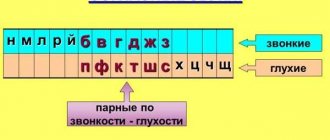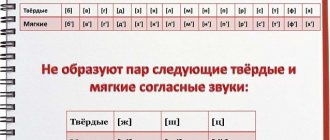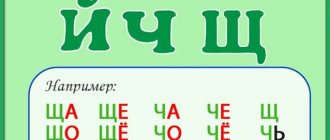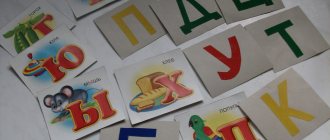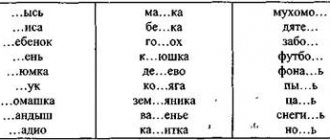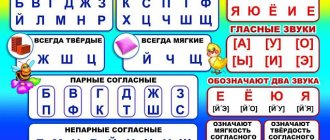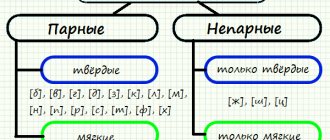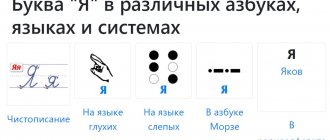In the history of a language, not only possible combinations of sounds change, but also the sounds themselves. Let's compare the phonetic system of modern Russian and Old Russian languages, classifying sounds according to their articulation and partly according to acoustic properties. Let's start with consonants at the present stage.
Note. Let us recall that articulation is the movement and interaction of the speech organs in the formation of sound.
In school teaching, children are usually taught to distinguish between consonants based on their voicedness/voicelessness and hardness/softness. We will consider a more complex classification that takes into account four characteristics:
- voice to noise ratio;
- place of education;
- method of education;
- presence of palatalization (softening).
Let's consider each point in detail.
Classification of consonant sounds of the Russian language
Consonant sounds can be hard and soft, dull and voiced. If sounds that according to these characteristics are divided into pairs, there are also unpaired ones. The table will help you understand the overall picture:
| Sound | Voiceless/voiced | Hard/soft | Paired/unpaired |
| b | voiced | solid | doubles |
| V | voiced | solid | doubles |
| G | voiced | solid | doubles |
| d | voiced | solid | doubles |
| and | voiced | solid | doubles |
| h | voiced | solid | doubles |
| To | voiced | solid | doubles |
| l | voiced | solid | doubles |
| m | voiced | solid | doubles |
| n | voiced | solid | doubles |
| P | deaf | solid | doubles |
| R | voiced | solid | doubles |
| With | deaf | solid | doubles |
| T | deaf | solid | doubles |
| f | deaf | solid | doubles |
| X | deaf | solid | doubles |
| ts | voiced | solid | unpaired |
| h | deaf | soft | unpaired |
| w | deaf | solid | doubles |
| sch | deaf | soft | unpaired |
| th | voiced | soft | unpaired |
| b' | voiced | soft | doubles |
| V' | voiced | soft | doubles |
| G' | voiced | soft | doubles |
| d' | voiced | soft | doubles |
| z' | voiced | soft | doubles |
| To' | voiced | soft | doubles |
| l' | voiced | soft | doubles |
| m' | voiced | soft | doubles |
| n' | voiced | soft | doubles |
| P' | deaf | soft | doubles |
| R' | voiced | soft | doubles |
| With' | deaf | soft | doubles |
| T' | deaf | soft | doubles |
| f' | deaf | soft | doubles |
| X' | deaf | soft | doubles |
It is worth understanding in more detail the characteristics that it describes.
So what are voiced and voiceless consonants? This is a characteristic of tonality that indicates whether the vocal cords are used when pronouncing a sound or not. If not, the sound is dull. If yes - sonorous.
Hardness and softness are also pronunciation characteristics. Soft sounds are produced when the middle back of the tongue rises towards the soft palate.
When pronouncing a consonant sound, the vocal tract always narrows, that is, the sound seems to overcome an obstacle.
Accordingly, consonants can be paired in terms of hardness/softness and dullness/voice, and then they will be called paired. Those who do not have such a pair are unpaired.
Consonants by place of noise production
According to the place of noise formation, all consonants are divided into labial and lingual, since their formation involves two active organs of speech - lips and tongue: the lower lip plays an active role in the formation of labial consonants, and the tongue plays an active role in the formation of lingual consonants. The active organs of speech act (articulate) in relation to the passive ones - the upper lip, alveoli, teeth, hard palate.
Labial and lingual consonants are divided into a number of smaller groups depending on which passive organs the active ones act on.
Labial consonants are divided into labiolabial and labiodental.
Labiolabial consonants are formed by closing the lower lip with the upper lip. These include: [p], [p'], [b], [b'], [m], [m'].
Labiodental consonants are formed by bringing the lower lip closer to the upper teeth. These include: [f], [f'], [v], [v'].
Lingual consonants are divided into anterior, middle and posterior lingual, depending on which part of the tongue - anterior, middle or posterior - plays an active role in the formation of sound.
Front-lingual consonants are divided into two groups: dental and palatodental.
Paired consonants
When forming dental consonants, the front part of the tongue closes or approaches the upper teeth. These include: [t], [t'], [d], [d'], [s], [s'], [z], [z'], [ts], [n], [n '], [l], [l']. When forming palatodental consonants, the front part of the tongue rises to the front part of the palate and there an obstruction is created in the area of the alveoli. These include: [w], [w], [w'], [w'], [h'], [p], [p'].
the middle lingual , and according to the passive organ the middle palatal , in the Russian language. When it is formed, the middle part of the tongue rises to the middle palate. Rear-lingual , and by the passive organ velar , the sounds [k], [g], [x], [k'], [g'], [x'] are formed by closure ([k, g]) or approach ([x] ) the back of the tongue with a fixed posterior palate.
Other characteristics of consonants
All consonant sounds are divided into three categories - sonorant (they are also called nasal - it’s clearer how they are pronounced), noisy (formed by bringing the organs of pronunciation closer together) and hissing (pronounced through the interdental gap). Consonant sounds are divided as follows:
- Sonorants , there are nine of them: [y'], [l], [l'], [m], [m'], [n], [n'], [r], [r'].
- Noisy , there are twenty-seven of them: [k], [k'], [p], [p'], [s], [s'], [t], [t'], [f], [f'] , [x], [x'], [ts], [h'], [w], [sch'], [b], [b'], [v], [v'], [g], [g'], [d], [d'], [g], [z], [z'].
- Hissing , there are four of them: [zh], [h'], [w], [sh'].
Consonant sounds can consist of only the voice, only noise, or noise and a voice added to it.
Method of education
The method of formation of consonant sounds is understood as the method of overcoming an obstacle in the speech organs by an air stream. On this basis, the consonants of the Russian language are divided into:
- stop (explosive) . They are formed if the speech organs completely close in the path of the air stream. The air, meeting such a barrier, breaks through it sharply, with force. These are the sounds [b], [b'], [p], [p'], [g], [g'], [k], [k'], [d], [d'], [t] , [T'];
- fricatives (frictional) . When articulating them, the organs of speech do not close completely, but only come closer, and the air stream passes through the gap between them: [v], [v'], [f], [f'], [zh], [zh'], [ z], [z'], [s], [s'], [j], [w], [sh̄'], [x], [x'];
- affricates (stop-frictional) , the articulation of which takes place in two stages. At the first stage, the exhaled air overcomes the closed organs of speech. Further, unlike explosive sounds, the bow does not break immediately, but first passes into a gap through which the air stream continues to flow: [ts], [h'];
- closure-passage . When they are formed, a complete closure of the speech organs occurs, but the air not only breaks this closure, but also partially bypasses it - either through the nasal cavity ( nasal sounds [m], [m'], [n], [n']), or through the oral cavity on the sides of the barrier ( lateral consonants [l], [l']);
- trembling (vibrants) . When pronouncing them, the speech organs repeatedly close and open: [р], [р'].
Test on the topic
- /5
Question 1 of 5How many consonants are there in Russian?
Start test
Hall of Fame
To get here, take the test.
- Sergey Efremov
4/5
- Stepan Schwartz
5/5
- Elena Chernova
5/5
- Anastasia Petrova
5/5
§2. Transcription
Transcription is a special recording system that displays sound. The following symbols are used in the transcription:
[ ] – square brackets indicating transcription.
[ ´] – emphasis. The accent is placed if the word consists of more than one syllable.
[b'] – the icon next to the consonant indicates its softness.
[j] and [th] are different designations for the same sound. Since this sound is soft, these symbols are often used with an additional designation of softness: [j'], [th']. This site uses the notation [th'], which is more familiar to most guys. The soft icon will be used to help you get used to the sound being soft.
There are other symbols. They will be introduced gradually as you become familiar with the topic.
The difference between noisy and sonorous
Not all consonants are noisy. In addition to them, there are also sonorous ones. This group includes [l], [l'], [m], [m'], [n], [n'], [p], [p'], [th']. Noisy ones differ from sonorant ones in a number of ways:
- When pronouncing sonorants, tone predominates in the voice, and when pronouncing noisy ones, noise predominates.
- Noisy consonants are usually devoiced at the end of the word. Sonorants, on the contrary, are not subject to deafening. Example: d in the word fruit is pronounced like [t] , but n in the word ringing does not change and sounds like [n] .
- Sonorant consonants do not form voiced-voiceless pairs, while most noisy consonants have pairs. The only exceptions are: [x], [x'], [ts], [h'], [w'] .
§9. Positional changes of sounds
Strong-weak positions for vowels. Positional changes of vowels. Reduction
People do not use spoken sounds in isolation. They don't need it. Speech is a sound stream, but a stream organized in a certain way. The conditions in which a particular sound appears are important. The beginning of a word, the end of a word, a stressed syllable, an unstressed syllable, a position before a vowel, a position before a consonant - these are all different positions. We will figure out how to distinguish between strong and weak positions, first for vowels, and then for consonants.
A strong position is one in which sounds do not undergo positionally determined changes and appear in their basic form. A strong position is allocated for groups of sounds, for example: for vowels, this is a position in a stressed syllable. And for consonants, for example, the position before vowels is strong.
For vowels, the strong position is under stress, and the weak position is unaccented . In unstressed syllables, vowels undergo changes: they are shorter and are not pronounced as clearly as under stress. This change of vowels in weak position is called reduction . Due to reduction, fewer vowels are distinguished in the weak position than in the strong position.
The sounds corresponding to stressed [o] and [a] after hard consonants in a weak, unstressed position sound the same. “Akanye” is recognized as normative in the Russian language, i.e. non-distinction between O and A in an unstressed position after hard consonants.
Compare:
- under stress: [house] – [dam] – [o] ≠ [a].
- without accent: [dama´] -home´- [gave´] -gave´ – [a] = [a].
The sounds corresponding to stressed [a] and [e] after soft consonants in a weak, unstressed position sound the same. The standard pronunciation is “hiccup”, i.e. inability to distinguish between E and A in an unstressed position after soft consonants.
Compare:
- under stress: [m'ech'] - [m'ach'] – [e] ≠.
- without accent: [m'ich'o´m]- sword´m - [m'ich'o´m]- ball´m - [and] = [and].
- But what about the vowels [i], [s], [u]? Why was nothing said about them? The fact is that these vowels in a weak position are subject to only quantitative reduction: they are pronounced more briefly, weakly, but their quality does not change. That is, as for all vowels, an unstressed position for them is a weak position, but for a schoolchild these vowels in an unstressed position do not pose a problem.
Compare:
[ski´ly], [in _lu´zhu], [n'i´t'i] – in both strong and weak positions the quality of vowels does not change. Both under stress and in unstressed position we clearly hear: [ы], [у], [и] and we write the letters that are usually used to denote these sounds.
Discussing the problem of interpretation
What vowel sounds are actually pronounced in unstressed syllables after hard consonants?
When performing phonetic analysis and transcribing words, many guys express bewilderment. In long polysyllabic words, after hard consonants, it is not the sound [a] that is pronounced, as school textbooks say, but something else.
They are right.
Compare the pronunciation of words: Moscow - Muscovites. Repeat each word several times and listen to what vowel sounds in the first syllable. With the word Moscow everything is simple. We pronounce: [maskva´] – the sound [a] is clearly audible. What about the word Muscovites? In accordance with the literary norm, in all syllables except the first syllable before stress, as well as the positions of the beginning and end of the word, we pronounce not [a], but another sound: less distinct, less clear, more similar to [s] than to .
In the scientific tradition, this sound is designated by the symbol [ъ]. This means that in reality we pronounce: [mjlako´] - milk´, [khrasho´] - good´, [kalbasa´] - sausage´. I understand that by giving this material in textbooks, the authors tried to simplify it. Simplified. But many children with good hearing, who clearly hear that the sounds in the following examples are different, cannot understand why the teacher and the textbook insist that these sounds are the same. In fact:
[vada´] – water´ – [v’d’inoy’] – water´y: [a]≠[ъ] [wood´] – firewood´ – [dr’v’ino´y’] – wood´y: [a] ≠[ъ]
A special subsystem consists of the realization of vowels in unstressed syllables after sibilants. But in the school course this material is not presented at all in most textbooks.
What vowel sounds are actually pronounced in unstressed syllables after soft consonants?
I feel the greatest sympathy for the children who study from textbooks that suggest in place of A, E, O after soft consonants to hear and transcribe the sound “and, inclined to e.” I consider it fundamentally wrong to give schoolchildren as the only option the outdated pronunciation norm - “ekanya”, which is found today much less often than “icanya”, mainly among very elderly people. Guys, feel free to write in an unstressed position in the first syllable before the stress in place of A and E - [i].
After soft consonants in other unstressed syllables, except for the position of the end of the word, we pronounce a short weak sound reminiscent of [i] and denoted as [b]. Say the words eight, nine and listen to yourself. We pronounce: [vo´s'm'] - [b], [d'e´v't'] - [b].
Do not confuse:
Transcription marks are one thing, but letters are another. The transcription sign [ъ] indicates a vowel after hard consonants in unstressed syllables, except for the first syllable before stress. The letter ъ is a solid sign. The transcription sign [b] indicates a vowel after soft consonants in unstressed syllables, except for the first syllable before stress. The letter ь is a soft sign. Transcription signs, unlike letters, are given in square brackets.
The end of a word is a special position. It shows clearing of vowels after soft consonants. The system of unstressed endings is a special phonetic subsystem. In it, E and A differ:
Building [building] - building [building], opinion [mn'e´n'ii'e] - opinion [mn'e´n 'iya'a], sea [mo´r'e] - sea [mo´r'a], will [vo´l'a] – at will [na_vol´l'e] . Remember this when doing phonetic analysis of words.
Check:
How your teacher requires you to mark vowels in an unstressed position. If he uses a simplified transcription system, that's okay: it's widely accepted. Just don’t be surprised that you actually hear different sounds in the unstressed position.
Strong-weak positions for consonants. Positional changes of consonants
For all consonants without exception, the strong position is the position before the vowel . Before vowels, consonants appear in their basic form. Therefore, when doing a phonetic analysis, do not be afraid to make a mistake when characterizing a consonant in a strong position: [dach'a] - da´cha, [t'l'iv'i´zr] - TV, [s'ino´n 'ims] - synonyms, [b'ir'o´zy] - birches, [karz'i´ny] - baskets. All consonants in these examples come before vowels, i.e. in a strong position.
Strong positions on deafness of voicedness:
- before vowels: [there] - there, [dam] - I will give,
- before unpaired voiced [p], [p'], [l], [l'], [n], [n'], [m], [m'], [th']: [dl'a] - for, [tl'a] – aphid,
- Before [v], [v']: [svoy'] - yours, [ringing] - ringing.
Remember:
In a strong position, voiced and voiceless consonants do not change their quality.
Weak positions in deafness and voicedness:
- before paired ones according to deafness-voicing: [sla´tk'iy] - sweet, [zū´pk'i] - teeth.
- before voiceless unpaired ones: [apkhva´t] - girth, [fhot] - entrance.
- at the end of the word: [zup] - tooth, [dup] - oak.
Positional changes of consonants according to deafness-voicing
In weak positions, consonants are modified: positional changes occur with them. Voiced ones become voiceless, i.e. are deafened, and the deaf are voiced, i.e. call out. Positional changes are observed only for paired consonants.
Stunning-voicing of consonants
Voiced deafening occurs in the following positions:
- before paired deaf ones: [fsta´v'it'] – insert,
- at the end of the word: [klat] – treasure.
Voicing of the deaf occurs in the position:
- before paired voiced ones: [kaz'ba´] – mowing´
Strong positions in terms of hardness and softness:
- before vowels: [mat'] - mother, [m'at'] - crush,
- at the end of the word: [out] - out, [out'] - stench,
- before labialials: [b], [b'], [p], [p'], [m], [m'] and posterior linguals: [k], [k'], [g], [g' ], [x[, [x'] for sounds [s], [s'], [z], [z'], [t], [t'], [d], [d'], [n ], [n'], [r], [r']: [sa´n'k'i] – San'ki (born fall), [s´ank'i] – sa´nki, [bu ´lka] - bun, [bu´l'kat'] - gurgle,
- all positions for the sounds [l] and [l']: [lba] - forehead, [pal'ba] - firing.
Remember:
In a strong position, hard and soft consonants do not change their quality.
Weak positions in hardness-softness and positional changes in hardness-softness.
- before soft [t'], [d'] for consonants [c], [z], which are necessarily softened: [c't'ep'], [z'd'es'],
- before [ch'] and [sh':] for [n], which is necessarily softened: [po´n'ch'ik] - donut, [ka´m'n'sh':ik] - mason .
Remember:
In a number of positions today, both soft and hard pronunciation is possible:
- before soft front-lingual [n'], [l'] for front-lingual consonants [c], [z]: snow - [s'n'ek] and [sn'ek], to anger - [z'l'it'] and [zl'it']
- before soft front-lingual [c'], [z'] for front-lingual [t], [d] - raise - [pad'n'a´t'] and [padn'a´t'], take away - [at'n'a´t'] and [atn'a´t']
- before soft front-lingual [t'], [d'], [s'], [z'] for front-lingual [n]: vintik - [v'i´n't'ik] and [v'i´nt 'ik], pension - [p'e´n's'ii'a] and [p'e´ns'ii'a]
- before soft labials [v'], [f'], [b'], [p'], [m'] for labials: enter - [f'p'isa't'] and [fp'is´ at'], rifme (Dan.fall.) - [r'i´f'm'e] and [r'i´fm'e]
Remember:
In all cases, positional softening of consonants is possible in a weak position. It is a mistake to write a soft sign when softening consonants positionally.
Positional changes of consonants based on the method and place of formation
Naturally, in the school tradition it is not customary to present the characteristics of sounds and the positional changes that occur with them in all the details. But the general principles of phonetics need to be learned. Without this, it is difficult to do phonetic analysis and complete test tasks. Therefore, below is a list of positionally determined changes in consonants based on the method and place of formation. This material is a tangible help for those who want to avoid mistakes in phonetic analysis.
Assimilation of consonants
The logic is this: the Russian language is characterized by similarity of sounds if they are similar in some way and at the same time are nearby.
Learn the list:
[c] and [w] → [w:] – sew
[z] and [zh] → [zh:] – compress
[s] and [h'] - at the root of words → [w':] - happiness, counting - at the junction of morphemes and words → [w':h'] - comb, dishonest, with what (the preposition followed by the word is pronounced together as one word)
[s] and [w':] → [w':] - split
[t] and [c] - in verb forms → [ts:] - smiles - at the junction of prefix and root → [tss] - pour out
[t] and [ts] → [ts:] - unhook
[t] and [h'] → [h':] - report
[t] and [t] and [w':]←[c] and [h'] – counting
[d] and [w':] ←[c] and [h'] - counting
Dissociation of consonants
Dissimilarity is a process of positional change, the opposite of assimilation.
[g] and [k'] → [x'k'] – light
Simplifying consonant clusters
Learn the list:
vstv - [stv]: hello, feel zdn - [zn]: latezdts - [sc]: under the bridle - [nc]: sun ndc - [nc]: Dutch ndsh - [ns:] landscape ntg - [ng]: x-ray rdc - [rts]: heart rdc - [rch']: heart stl - [sl']: happy stn - [sn]: local
Pronunciation of sound groups:
In the forms of adjectives, pronouns, participles there are letter combinations: wow, his. Instead of g, they pronounce [v]: him, beautiful, blue. Avoid reading letter by letter. Pronounce his blue, beautiful words correctly.
§10. Letters and sounds
Letters and sounds have different purposes and different natures. But these are comparable systems. Therefore, you need to know the types of ratios.
Types of relationships between letters and sounds:
- The letter denotes a sound, for example vowels after hard consonants and consonants before vowels: weather.
- The letter does not have its own sound meaning, for example ь and ъ: mouse
- The letter denotes two sounds, for example, iotated vowels e, e, yu, i in the positions:
- the beginning of a word
- after vowels,
- after the separators ь and ъ.
- A letter can denote a sound and the quality of a preceding sound, such as iotated vowels and and after soft consonants.
- A letter can denote the quality of the preceding sound, for example ь in the words shadow, stump, firing.
- Two letters can mean one sound, often a long one: sew, compress, rush
- Three letters correspond to one sound: smile - ts - [ts:]
§7. Indication of softness of consonants in writing
Let's take a break from pure phonetics. Let's consider a practically important question: how is the softness of consonants indicated in writing?
There are 36 consonant sounds in the Russian language, including 15 hard-soft pairs, 3 unpaired hard and 3 unpaired soft consonants. There are only 21 consonants. How can 21 letters represent 36 sounds?
Various methods are used for this:
- iotized letters e, e, yu, i after consonants, except sh, zh and c, unpaired in hardness-softness, indicate that these consonants are soft, for example: aunt - [t'o´t'a], uncle - [Yes Yes];
- letter and after consonants, except sh, zh and c. The consonants denoted by the letters sh, zh and c are unpaired hard. Examples of words with the vowel letter and: ni´tki - [n'i´tk'i], leaf - [l'ist], cute - [m'i´lyy'];
- the letter ь, after consonants, except sh, zh, after which the soft sign is an indicator of the grammatical form. Examples of words with a soft sign: request - [proz'ba], stranded - [m'el'], distance - [dal'].
Thus, the softness of consonants in writing is conveyed not by special letters, but by combinations of consonant letters with the letters i, e, e, yu, i and ь. Therefore, when parsing, I advise you to pay special attention to adjacent letters after the consonants.
Discussing the problem of interpretation
School textbooks say that [w] and [w'] are unpaired in hardness and softness. How so? We hear that the sound [w'] is a soft analogue of the sound [w]. When I was studying at school myself, I couldn’t understand why? Then my son went to school. He had the same question. It appears in all children who approach learning thoughtfully.
Confusion arises because school textbooks do not take into account that the sound [w'] is also long, but the hard sound [sh] is not. Pairs are sounds that differ in only one attribute. And [w] and [w'] - two. Therefore [w] and [w'] are not pairs.
For adults and high school students.
In order to maintain correctness, it is necessary to change the school tradition of transcribing the sound [w']. It seems that it is easier for the guys to use one more additional sign than to face an illogical, unclear and misleading statement. It's simple. So that generation after generation does not rack their brains, it is necessary to finally show that a soft hissing sound is long.
For this purpose, in linguistic practice there are two icons:
1) superscript above the sound; 2) colon.
Using a superscript is inconvenient because it is not provided by the set of characters that can be used in computer typing. This means that the following possibilities remain: using a colon [w':] or a grapheme denoting the letter [w']. It seems to me that the first option is preferable. Firstly, children often mix sounds and letters at first. The use of a letter in transcription will create the basis for such confusion and provoke an error. Secondly, children are now starting to learn foreign languages early. And the [:] symbol, when used to indicate the length of a sound, is already familiar to them. Thirdly, transcription indicating longitude with a colon [:] will perfectly convey the features of the sound. [sh':] - soft and long, both features that make up its difference from the sound [sh] are presented clearly, simply and unambiguously.
What advice can you give to children who are now studying using generally accepted textbooks? You need to understand, comprehend, and then remember that in fact the sounds [w] and [w':] do not form a pair in terms of hardness and softness. And I advise you to transcribe them the way your teacher requires.
